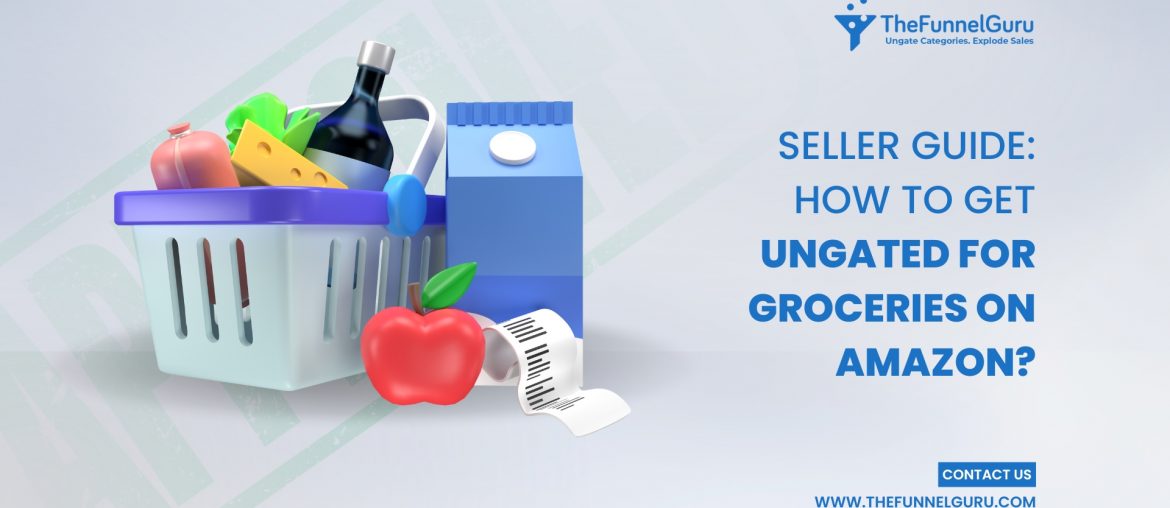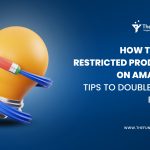Amazon is the undisputed giant of the huge digital e-commerce world, a limitless marketplace with limitless potential for businesses. However, despite the rush and bustle of this virtual arena, budding businesses face a conundrum: limited access to Amazon grocery ungating. The subject of this article digs into the complex issues that Amazon sellers experience when seeking to join the profitable realm of online grocery sales, highlighting the roadblocks they face and throwing light on potential solutions.
Ungating the Grocery: The Perplexities of Ungating Groceries as Amazon Restricts Access
#1: The Allure of Grocery Sales on Amazon
- Make a strong case for the large customer demand for groceries online, emphasizing the ease and efficiency it provides.
- With its ever-expanding customer base and formidable logistical infrastructure, Amazon is a dominant player in the online grocery sector.
#2: The Gating Dilemma
- Explain Amazon’s decision to restrict access to ungating groceries, claiming quality control, regulatory compliance, and food safety as justifications.
- Discuss how this limitation has unintentionally established a barrier for ambitious sellers, limiting their access to this growing market area.
#3: The Complexity of the Application Process
- Describe the extensive and frequently complex stages required in the application process to become an unrestricted Amazon groceries seller.
- Address the extensive documentation requirements, which can be burdensome for small enterprises and startups, such as permits, licenses, and certificates.
- Mention the lengthy waiting periods and ambiguity surrounding the approval process, which leaves sellers in limbo.
#4: The Importance of Quality Control and Compliance
- Consider Amazon’s emphasis on quality control and compliance in the grocery business.
- Highlight Amazon’s rigorous standards, which sellers must satisfy to ensure customer satisfaction and avoid the selling of outdated or hazardous products.
- Address the difficulties sellers confront in adopting and maintaining rigorous quality control methods, particularly in small-scale enterprises with limited resources.
#5: Seeking Solutions and Alternative Avenues
- Present strategies and concepts for sellers to more efficiently manage the ungating process, including thorough documentation and preparation.
- Emphasize alternative platforms and marketplaces that offer grocery sales options, such as Walmart, eBay, or specialized food-centric platforms.
- Address the possible advantages of collaborating with existing grocery distributors or wholesalers to obtain access to markets other than Amazon.
#6: Adapting to Changing Landscapes
- In the ever-changing e-commerce landscape, emphasize the need for adaptation and agility.
- Encourage sellers to expand their sales channels by experimenting with social media platforms, developing a brand presence, and cultivating consumer loyalty.
- Address how modern technologies such as blockchain and direct-to-consumer platforms have the potential to revolutionize the grocery business and open up new development opportunities.
Get Amazon Grocery Ungated in 5 Easy Steps
Do you want to build your Amazon business by selling groceries on the platform? Excellent decision! Given the growing popularity of online grocery shopping, selling groceries on Amazon can be a successful business. To get started, you must go through a process known as “getting ungated” for groceries on Amazon.
Here are some methods you can use to attract Amazon sellers, as well as some current statistics:
1. Fulfill Amazon’s General Requirements
One of the most essential steps in being ungated for selling groceries on Amazon is meeting Amazon’s standard requirements. Amazon establishes these regulations to guarantee that sellers satisfy specific standards and preserve the quality and safety of the products they offer. You can boost your chances of being permitted to sell groceries on the marketplace by following these guidelines. Here are some important factors to consider:
- Product Quality: Amazon places a high priority on product quality. This includes making sure that the things you provide are in outstanding shape, free of flaws, and by all applicable laws and regulations. Maintaining high-quality items can help you not only be allowed to sell groceries but will also draw more customers in the long term.
- Packaging and Labeling: Proper packing and labeling are essential for selling groceries on Amazon. To minimize damage during transportation, your products should be properly wrapped, and the packaging should clearly show all relevant information such as ingredient lists, nutritional values, expiration dates, and any other needed labeling information.
- Storage and Handling: Amazon requires sellers to properly handle and store grocery supplies. This includes providing optimal temperature management, storage conditions, and the storage of volatile goods. Following these standards helps to ensure product freshness and safety, which is critical for customer satisfaction.
- Paperwork and Certifications: To guarantee compliance with food safety regulations, Amazon might ask for specific paperwork and certifications. These may include food handling, production, or distribution licenses, permits, or certificates. When applying to sell food on Amazon, it is critical to have all of the relevant documentation in order and easily available.
The demand for food on Amazon has rapidly increased in recent years. According to industry forecasts, the online grocery business will develop rapidly, with a significant increase in online grocery sales. This creates a big opportunity for sellers who want to enter this industry.
You demonstrate your dedication to supplying high-quality, safe, and compliant grocery products by satisfying Amazon’s general standards. This not only increases your chances of being ungated for groceries, but it also helps you create trust with customers. Additionally, selling groceries on Amazon can provide you with access to a huge customer base, better visibility, and the convenience of Amazon’s fulfillment services.
Recent Stats: The number of third-party sellers on Amazon has constantly increased, with over 2.5 million active sellers globally in 2021.
2. Meet Amazon’s Grocery-specific Requirements
Ungating for Groceries on Amazon entails satisfying particular Amazon standards to assure the quality and safety of the products being sold. These rules exist to safeguard both sellers and customers.
Sellers must follow various norms and restrictions to fulfill Amazon’s grocery-specific criteria. These are some examples:
- Product Categories: Amazon offers a pre-approved list of grocery categories. Sellers must guarantee that the things they want to sell fall into one of these categories. Beverages, snacks, pantry essentials, and personal care products are examples of acceptable categories.
- Brand Registry: Sellers must register their brand using Amazon’s Brand Registry program. This program protects the brand’s intellectual property rights while also ensuring the authenticity of the products offered.
- Quality Control: Amazon has strict quality control criteria for groceries. Sellers must verify that their products fulfill these requirements, which include correct packaging, labeling, and expiration dates. To help customers in making educated purchase decisions, it is critical to give accurate and extensive product information.
- Documentation: Sellers must offer the appropriate documents to demonstrate the authenticity and safety of their products. Certificates of analysis, production licenses, and conformity with essential food safety requirements are examples of this.
- Sourcing Inventory: Amazon requires sellers to acquire their groceries from certified suppliers. Sellers should build ties with reliable suppliers and make certain that the products they buy are authentic and of excellent quality.
Sellers that match these standards can get access to Amazon’s Grocery category, tap into a big customer base, and profit from the platform’s powerful logistics and fulfillment infrastructure.
According to recent figures, the demand for online grocery is steadily expanding. According to research, online grocery sales in the United States alone would exceed $105 billion (about $320 per person in the US) in 2020, representing a 52% rise over the previous year. This trend is projected to continue as more people embrace the convenience of online grocery shopping.
Selling groceries on Amazon enables sellers to capitalize on this expanding sector and reach a large customer base. Access to millions of active buyers, faster shipping and fulfillment processes, and strong marketing tools are all available through the platform.
It is crucial to note, however, that achieving Amazon’s grocery-specific criteria necessitates extreme care to detail and compliance. Sellers should properly investigate and comprehend Amazon’s criteria, ensuring that their products satisfy the essential requirements to give customers a great purchasing experience.
3. Gather Necessary Documentation
Amazon Grocery Ungating is a critical step for sellers hoping to enter the profitable sector of selling food and groceries on the platform. Gathering appropriate documents, which includes giving the necessary papers and information to fulfill Amazon’s demanding standards, is a key stage in this process.
To put it simply, assume you’re about to join a highly regulated marketplace such as Amazon, where they want to verify the safety and quality of the products offered. Amazon must verify that you are a valid and trustworthy seller before granting you access to the Grocery category.
You’ll need to provide papers that confirm your eligibility and compliance with Amazon’s regulations when it comes to getting relevant proof. This usually includes things like:
- Business Licenses: Amazon wants to make sure you’re running a real company. As a result, they might ask for your company licenses or permissions, such as a reseller certificate or, if necessary, a food handling license.
- Product Invoices: Amazon wants to know that you have a credible source for the Grocery products you want to sell. As confirmation of your inventory, they may request invoices or receipts from your suppliers.
- Certifications and Compliance: Specific certifications can be required for some food and grocery products to guarantee they fulfill safety and quality requirements. Depending on the products you want to sell, Amazon can require documentation such as FDA registrations, organic certifications, or third-party lab test reports.
- Product Labels and Packaging: Providing accurate and compliant product labels and packaging is critical. Amazon can ask for photographs or samples to check that your products are labeled and wrapped correctly.
By compiling and submitting this required documentation, you demonstrate to Amazon that you are a genuine seller devoted to supplying customers with safe and dependable products. This enhances trust and your chances of being given admission to the Groceries category.
It is important to note that Amazon’s standards may change over time, and they may have special rules or documentation needs. As a result, it’s always a good idea to remain up to speed on Amazon’s seller resources and rules to ensure you’re fulfilling the most recent criteria.
According to recent data, the Grocery category on Amazon has grown significantly, with more individuals relying on online purchasing for their food and grocery needs. This provides retailers with an excellent chance to access an extensive customer base and boost their sales potential. Sellers can position themselves to take advantage of this developing industry and build their business on Amazon by successfully acquiring the appropriate papers and being ungated for Groceries.
Recent Stats: Online grocery sales accounted for around 12% of total grocery sales in the United States in 2021, highlighting the growing trend of consumers opting for digital grocery shopping.
4. Prepare High-quality Product Listings
Preparing high-quality product listings is a critical step in being ungated on Amazon for Groceries. Amazon sellers who wish to sell groceries should make sure their product listings are appealing and accurate, and follow Amazon’s criteria. Here’s why it matters, as well as some current statistics to prove it.
- Attracting Buyers: High-quality product listings help potential buyers notice you. Well-written titles, thorough descriptions, and eye-catching photographs help your products stand out from the crowd. Indeed, studies have shown that optimized product listings can result in a considerable rise in sales, with some sellers experiencing a 30% increase in conversions.
- Building Trust: When it comes to selling groceries online, trust is essential. Customers want to know that the products they buy are of high quality and safe. Customers will be more inclined to pick your products if you provide precise and thorough information such as ingredients, nutritional statistics, and expiration dates. According to recent polls, 88% of online customers believe that product information is critical when making purchase decisions.
- Meeting Amazon’s Standards: Amazon has certain standards for displaying products, particularly groceries. To maintain compliance and prevent any difficulties or penalties, sellers must follow these rules. This involves delivering up-to-date and correct information, employing high-resolution photographs, and conforming to certain packaging and labeling regulations. By following these instructions, you boost your chances of being ungated and selling groceries on Amazon.
- Recent Study: Recent research shows the importance of high-quality product listings on Amazon. According to Jungle Scout research, optimizing product names alone can result in a 53% improvement in organic keyword ranking. Another study found that sellers who engage in professional product photography get a 5% to 10% rise in sales compared to those who utilize lower-quality photographs.
Preparing high-quality product listings, in simple terms, entails making the grocery store’s items look their best and offering accurate and compelling information to potential buyers. By doing so, you boost your chances of drawing more customers, establishing trust, satisfying Amazon’s standards, and eventually being approved to sell food on Amazon. Remember that paying attention to detail and presenting your products in the best possible light can make or break your career as an Amazon seller.
5. Apply for approval
This is the final phase in the process, and it is critical for Amazon sellers who wish to become ungated or get permission to sell food on the platform. Due to the growing popularity of online grocery shopping, selling groceries on Amazon might be an economically viable choice.
When you apply for approval to sell groceries on Amazon, you’re effectively asking Amazon for permission to list and sell groceries on their site. To assure the quality and safety of the grocery products offered on Amazon, several criteria and norms are in place.
To get approved, you must fulfill Amazon’s specified requirements. Having a recognized business, producing relevant documents, and showing compliance with food safety rules are some of the factors that can be considered. Amazon wants to guarantee that sellers can manage perishable products while maintaining the highest quality standards.
Let’s take a look at some recent statistics to demonstrate the possibility of selling groceries on Amazon:
- Growing business: In recent years, the online grocery business has grown significantly. According to industry estimates, online grocery sales will reach 8 billion dollars (about $25 per person in the US) by 2025.
- The dominance of Amazon: Amazon is a major participant in the e-commerce business, with an extensive customer base. It provides a wide choice of grocery products and has a solid reputation for dependable and convenient online shopping.
- Increased Online Grocery Buying: The epidemic of COVID-19 has hastened the trend of online grocery buying. Many people have found the convenience of having food delivered to their door, which has increased demand for online grocery services.
- Prime Member Advantage: Selling groceries on Amazon might provide you access to Amazon Prime members, who are recognized for their loyalty and greater average spending. Prime members frequently choose to buy food through Amazon because of the additional perks of rapid shipping and special deals.
You can tap into this increasing business and reach a wide spectrum of customers by getting ungated and being allowed to sell groceries on Amazon. To enhance your chances of acceptance, thoroughly follow Amazon’s rules and supply all required information. Once you’ve been authorized, you can start selling your grocery products and use Amazon’s powerful platform to develop your business.
Recent Stats: Amazon Prime members spent an average of $3,000 per year on the platform in 2021, indicating the potential for increased exposure and sales when targeting this customer base with your grocery offerings.
Final Thoughts about Selling Groceries on Amazon and Increasing Your Amazon Sales
You can sell products on Amazon by following these steps and capitalizing on the increasing need for online grocery shopping. Keep in mind that the process might vary significantly depending on your area and the products you wish to sell. To compete in the competitive world of grocery sales, be educated about Amazon’s regulations and guidelines, and ensure that you maintain the highest levels of product quality, customer service, and compliance.
While Amazon’s restrictions on ungating groceries pose significant hurdles for sellers, it is critical to see it as an opportunity for adaptation and research. Sellers can overcome these hurdles and carve their route to success in the changing world of e-commerce by learning the nuances of the application process, embracing alternative platforms, and remaining tuned in to industry trends. As the old phrase goes, “When one door closes, another opens.” It is up to Amazon sellers to grab the opportunities that exist outside the limited gate and expand the field of online grocery sales.
Follow Amazon ungating blogs for more details, news, and the most recent trends on Amazon ungating to increase your sales.







